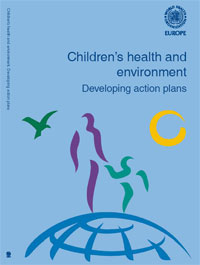 |
CHILDREN'S HEALTH AND ENVIRONMENT
DEVELOPING ACTION PLANS
By Lucianne Licari, Leda Nemer
and Giorgio Tamburlini
WHO, 2005, 96 pages
|
Полный текст книги см. в Интернете по адресу:
http://www.who.dk/document/E86888.pdf?language=Russian
На Четвертой конференции на уровне министров по окружающей
среде и охране здоровья в 2004 году страны Европейского региона
ВОЗ взяли на себя обязательства по построению здорового будущего
для детей, приняв Европейский план действий "Окружающая среда
и здоровье детей", который обеспечивает основу для действий,
осуществляемых 52 различными странами региона. Целью данной публикации
является предоставление странам руководства и инструментария, необходимого
для реализации Плана действий на местном и национальном уровнях,
а также в масштабах всего региона. При этом ставится цель выработать
на основе рамочного документа национальные планы действий с учетом
конкретных обстоятельств, приоритетов и ресурсов каждой страны.
Книга состоит из трех частей. В части I приводятся научные данные
о подверженности детей воздействию экологических факторов риска,
а также обзор экологических факторов риска и их последствий для
здоровья детей. Основу публикации составляет часть II, в которой
приводятся таблицы предлагаемых действий, ориентированных на детей,
и, таким образом, конкретные пути возможных действий стран с целью
уменьшения воздействия экологических факторов риска на детей и улучшения
их здоровья. Это дает странам возможность действовать в соответствии
со своими собственными национальными приоритетами, одновременно
затрагивая в своей деятельности экологические факторы риска в масштабах
всего региона. В части III основное внимание уделяется инструментарию,
необходимому для обеспечения реализации национальных планов действий.
Данная публикация призвана служить руководством для стран, желающих
построить безопасное и здоровое будущее для всех детей Европейского
региона.
Contents
Foreword
Preface
Abbreviations
Part I.Background
1. Scope and purpose
The road to Budapest
Need for a children's environmental and health action plan for Europe
2. Children's vulnerability to biological and social factors
in the physical environment
Biological factors
Critical windows of susceptibility during growth and development
Immature metabolism
Greater exposure
Early environmental exposures leading to later harm to health
Multiple exposures
Taking account of children's unique vulnerability in toxicological
risk assessment
Age-specific exposure patterns
Economic, social and psychosocial factors
Unequal distribution of the burden of environment-related disease
Importance of different factors in shaping behaviour and lifestyle
Complex causality: the need for a multisectoral approach
3. Overview of environmental risk factors and their effects
on children's health
Introduction
Poor indoor air quality
Outdoor air pollution
Poor water supply and inadequate sanitation
Inadequate nutrition
Microbiological food contamination
Inadequate building standards and unsafe play materials
Hazardous chemicals
Ionizing and non-ionizing radiation
Noise
Mobility and transport patterns
Natural disasters and climate change
Occupational risk factors
Critically adverse social environments
Consequences of armed confl ict
Summary: effects of main environmental risk factors on children's
health
Part II. Towards national action plans
4. Tables of child-specific actions
Scope and objectives
Structure and terminology
Six categories of action
Three types of evidence
Regional Priority Goal I: safe water and adequate sanitation
Regional Priority Goal II: injury prevention and supportive environments
Regional Priority Goal III: reduced disease from air pollution
Regional Priority Goal IV: reduced risks from chemical and physical
agents
Additional environmental health risk factors
Cross-sectoral issues
5. International support for CEHAPs
The European Environment and Health Committee (EEHC)
Partners for collaborative research or implementation of plans
Common focus for accessing resources from international organizations
Part III. Tools for implementation
6. Setting priorities
Introduction
Two approaches to setting priorities
Setting priorities for national CEHAPs
Types of action
Criteria for setting priorities
7. Building partnerships for implementation
Introduction
Building partnerships at the national level
The local community
The education sector
Professional and lay associations
Civil-society organizations and NGOs
Children and young people
Making partnerships effective
Building partnerships within the European Region
8. Dealing with uncertainty: using the precautionary principle
The context of precautionary action to protect children
Scope and history
A framework for precaution
Application of the precautionary principle
Types of precautionary action
Conclusions
9. Advocacy, information, education and communication
Definitions
Importance to children's health and environment
10. Monitoring the CEHAPE: children's environmental health indicators
Environmental health indicators
Children's environmental health indicators
Purpose and users
Development of indicators to monitor the CEHAPE
Importance of policy action indicators
Integration of indicators with a pan-European environment and health
information system
References
Annex 1. Children's Environment and Health Action Plan for
Europe (CEHAPE)
Introduction: background and rationale
Regional Priority Goals, actions and expected health outcomes
International collaboration
National children's environment and health action plans
Annex 2. Mechanisms to enhance the effectiveness of policy-making
Annex 3. Definitions of terms used in the text
|

